Delicious Chicken Enchilada Recipe with Green Sauce
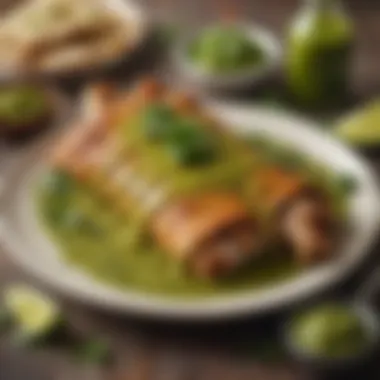
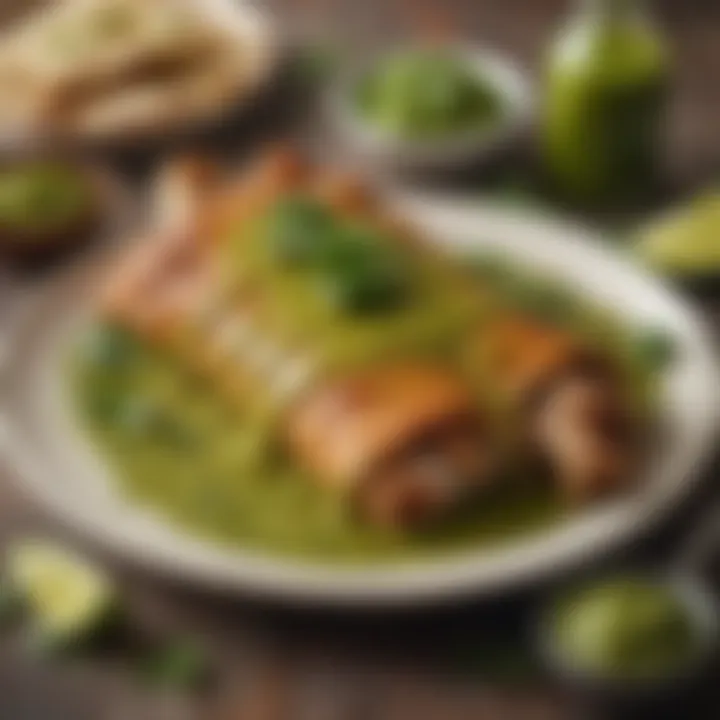
Recipe Highlight
Chicken Enchiladas verde are a classic dish, featuring savory shredded chicken, wrapped in corn tortillas, and enhanced by a bright green sauce. The combination creates a meal that is savory yet light, ensuring you feel satisfied without heaviness.
Essential Ingredients:
- Shredded chicken (cooked)
- Corn tortillas
- Green enchilada sauce (store-bought or homemade)
- Shredded cheese (cheddar or Monterey jack)
- Onion (chopped)
- Olive oil
- Cilantro (for garnish)
Estimated Time to Prepare:
Approximately 45 minutes
Servings:
Serves 4
Step-by-Step Instructions
- Preheat the Oven: Start by preheating the oven to 375°F (190°C). This ensures that the enchiladas bake perfectly.
- Prepare the Filling: In a skillet over medium heat, add olive oil and chopped onion. Sauté until the onion is soft. Mix in the shredded chicken and half of the green enchilada sauce, cooking for another 2-3 minutes.
- Assemble the Enchiladas: Take a corn tortilla, fill it with the chicken mixture, and carefully roll it up. Place the enchilada seam-side down in a baking dish. Continue until all tortillas are filled.
- Create the Sauce Layer: Pour the remaining green sauce over the rolled enchiladas. Sprinkle shredded cheese atop the dish, helping to create a delicious crust.
- Bake: Place the dish in the oven. Bake for approximately 20 minutes, or until the cheese is melted and slightly golden.
- Garnish: Once the enchiladas are out of the oven, sprinkle chopped cilantro on top for freshness.
Prelims to Chicken Enchiladas
Chicken enchiladas represent more than just a meal; they are a comforting dish deeply intertwined with cultural appreciation and culinary history. Significant in Mexican cuisine, enchiladas offer various preparation styles and flavors. Understanding the basics of chicken enchiladas lays the groundwork for mastering this delightful dish. It sets expectations regarding ingredients, flavors, and techniques.
Time spent in the kitchen could be minimal when procedures are clear and straightforward. Ideal for busy households, this exploration aims to facilitate meal preparation while doing justice to the vibrant palate of enchiladas. Moreover, by emphasizing the unique aspects of this dish, readers gain insights into enhancing flavor, texture, and visual appeal through competent execution and thoughtful layering of tastes and aromas.
Historical Context of Enchiladas
Enchiladas have deep roots in Mexican culinary history, tracing back to ancient times. The word enchilada is derived from the Spanish verb enchilar, which refers to adding chili to food. Over the centuries, this dish evolved from its early beginnings, when indigenous communities used basic ingredients to what it is today—a celebrated dish across tabletops worldwide.
Enchiladas existed in various forms in pre-Columbian culture, but the modern version emerged with influences from European colonization and climate influences across the regions. They were once a simple mix of corn tortillas dressed with locally suitable fillings, such as vegetables and meats. Excitement builds, however, with the introduction of various sauces crafted from locally sourced ingredients, reflecting regional characteristics and tastes.
The adaptation of enchiladas into a variant involving chicken and flavor-focused sauces opens a gateway for creativity in culinary formats. A historical lens on enchiladas indeed sheds light on how traditional cooking remains rooted while modern interpretations thrive deliberately, making it a fundamental aspect worth delving into.
Why Choose Green Sauce?
Opting for green sauce in enchiladas elevates this timeless dish of chicken. Grean sauce, or salsa verde, is made primarily from tomatillos, green chilies, and sometimes herbs. By choosing green sauce, chefs readily take advantage of the bright citrusy and mildly zesty notes that complement the filling.
The benefits do not stop there. Green sauce generally offers a fresher taste than its red counterpart, appealing for lighter options or warmer weather occasions. A balance between acidity and complexity enriches chicken enchiladas without overpowering critical flavors. In today's culinary landscape, green sauce represents an encouraging preference by those seeking refined dimensions in enjoying traditional dishes.
Integrating green sauce opens possibilities for customization. Cooks can modify heat levels, textures, and vibrant colors, allowing personalized culinary expressions. This significance reflects varied cultural heritages while allowing each rendering of green sauced chicken enchiladas to stand alone tastefully.
Ingredients Overview
In any recipe, understanding the ingredients not only plays a crucial role in achieving the intended flavor but also improves overall meal satisfaction. When it comes to chicken enchiladas with green sauce, a thoughtful selection of ingredients can elevate the dish from ordinary to extraordinary. This section outlines the components that you will need, focusing on their specific benefits and considerations.
Main Ingredients
The main ingredients for the chicken enchiladas are fairly simple yet each one contributes significantly to the dish's authenticity and taste. These include chicken, tortillas, and cheese. The chicken, which can be either grilled or shredded, offers a lean protein basis. Using high-quality chicken ensures the dish remains moist and flavorful.
The tortillas are the backbone of the enchilada. It is recommended to use corn tortillas for their traditional texture and flavor. Flour tortillas can be used but will yield a different eating experience. Ensure they are fresh, as stale tortillas can lead to undesirable results in both texture and taste.
Lastly, cheese is imperative. Selecting a good melting cheese such as Monterey Jack can enhance the overall richness of the enchiladas. Finding a balance between cheese and other component help to achieve a well-rounded medley of flavors.
Sauce Ingredients
The green sauce is the star of this recipe. Typically made from tomatillos, jalapeños, and cilantro, the sauce should be fresh and vibrant. Tomatillos give a unique tanginess that complements the dish and balances the protein nicely. You may blend these with garlic and onions, which add depth and complexity to the sauce.
Herbs and spices are also essential. Fresh cilantro adds brightness while jalapeños add just enough heat without overwhelming the palate. Adjust the quantity based on personal preference. The proper ratios here influence the overall flavor profile significantly.
Garnishing Options
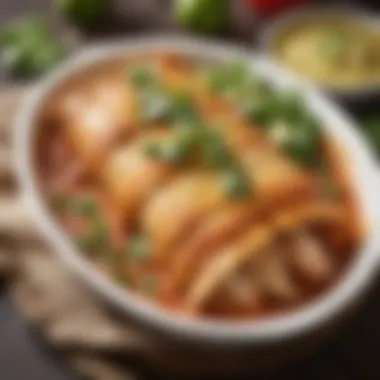
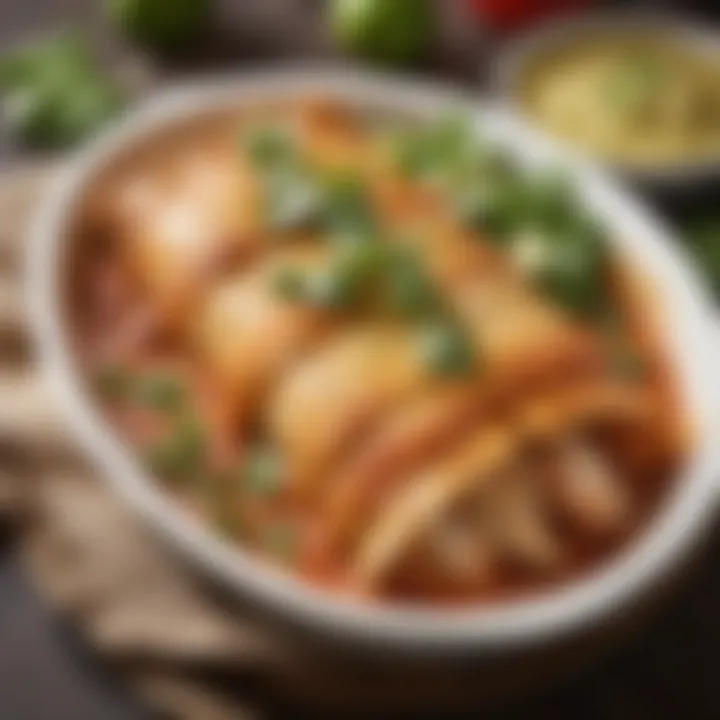
Once the enchiladas are prepared, garnishing completes the dish visually and with flavor. Some common garnishing choices include diced avocados, sour cream, and fresh cilantro. Avocados provide a creamy texture. Sour cream balances the heat from the jalapeños, while cilantro ties in the fresh taste from the sauce.
Adding a sprinkle of cheese on top before serving can enhance the appeal. You might consider thinly sliced radishes for a bit of color and crunch. The garnishes may be adjusted according to individual taste and dietary restrictions, allowing for personalization of each plate.
The quality and freshness of ingredients are integral to maximizing flavor in the chicken enchiladas. Taking care to select and prepare these elements thoughtfully will leave a lasting impression.
Preparation Steps
In the process of preparing chicken enchiladas, each procedural step plays a pivotal role in optimizing flavor and ensuring an enjoyable experience. Understanding the significance of these steps allows cooks to create a dish that is both satisfying and efficient. Preparation involves multiple stages, from selecting the right ingredients to executing technique flawlessly. A solid foundation in preparing these elements encourages success in the overall cooking process.
Preparing the Chicken
Selecting and preparing the chicken comes first and is vital for achieving great taste. Boneless, skinless chicken breast is popular and easy to manipulate. You can choose chicken thighs instead for richer flavor. What you decide depends on personal preferences. Initiate by seasoning the chicken. Salt, pepper, and garlic powder simplify yet enhances the flavor significantly. After seasoning, cook the chicken by either poaching it in broth or roasting it in the oven with herbs. Ensure that it reaches an internal temperature of 165°F for food safety.
Once cooked, let the chicken cool slightly. Shredding the chicken after cooling is easier and helps mix it into the other components later. Use two forks to shred or your fingers if more convenient. Place the shredded chicken in a bowl and incorporate any spices or sauces you prefer at this stage. This customization adds uniqueness to your enchiladas.
Making the Green Sauce
The green sauce, known as salsa verde, is paramount in achieving that vibrant and piquant flavor profile. You can start this process by gathering fresh tomatillos, jalapeños, and cilantro. First, rinse the tomatillos and remove their husks. Next, broil them until roasted and their skins are slightly charred. Do the same with jalapeños, removing seeds for reduced heat.
Combine the tomatillos, jalapeños, cilantro, lime juice, and a pinch of salt in a blender or food processor. Blend until the mixture is smooth. Adjust seasoning as needed. Ensure the sauce maintains a consistent texture; you can add water if it becomes too thick. This sauce serves as not only a filling but also adds moisture during the baking process. Incorporating green sauce introduces – clearly – authentic Mexican flavor to the enchiladas.
Assembling the Enchiladas
This step brings together all the prepared components. Begin with tortilla selection. Corn tortillas are traditional for enchiladas due to their authentic flavor and texture. Heat the tortillas briefly on a skillet or in the microwave to prevent cracking while rolling.
Take a tortilla and add shredded chicken, generous spoonful of green sauce, and optionally cheese in a line down the center. Roll the tortilla and place it seam side down in a baking dish. Repeat with remaining tortillas, carefully aligning them side by side. A cohesive roll minimizes leaking during baking. After filling all tortillas, cover the top with remaining green sauce and a sprinkling of cheese before placing the dish in the oven.
Pro Tip: Do not overcrowd the baking dish; a relaxed contour leads to better cooking outcomes.
Following these nuanced setups leads to an appealing, delicious culinary experience. The preparation steps set the stage for a rich flavor, ensuring that each enchilada becomes splendidly tantalizing. By understanding and executing these details well, anyone can present a thoughtful and skillful dish.
Cooking Techniques
In the preparation of chicken enchiladas with green sauce, the chosen cooking techniques play a pivotal role. The methods used not only affect the flavor and texture of the dish but also determine the overall success in achieving the desired results. Whether one opts for baking, stovetop methods, or slow-cooking, understanding these techniques ensures that every enchilada turns out delectable.
Cooking techniques are essential as they enhance the flavors, maintain moisture, and influence presentation. Careful selection can also dramatically affect the nutritional profile. Knowing how to blend these methods can lead to satisfying meals while minimizing time spent in the kitchen.
Oven Baking vs.
Stovetop
Oven baking offers an ease and efficiency that stovetop cooking may lack. When using an oven, the enchiladas are enveloped in heat from all sides. This allows for an even cooking process. The result is often a beautifully browned top layer, which many find visually appealing.
Using the oven is particularly advantageous in a busy household. It allows one to prepare multiple trays at once. This method is suitable for cooking larger quantities of enchiladas without compromising their integrity. It can be particularly helpful if hosting friends or family gatherings.
However, stovetop cooking presents its own set of benefits. When cooked on the stovetop, enchiladas can quickly absorb flavors from their surroundings—like spices and herbs being sautéed. It allows for quicker assembly and cooking without the need for pre-heating an oven. Stovetop methods may result in softer tortillas and moist, flavorful fillings.
In summary, both methods have their respective strengths and can produce delightful results. Depending on time and available resources, one can decide based on preferences for texture and flavor
Using a Slow Cooker
Slow cooking has emerged as a favored technique, especially for those who lead busy lives. This method guarantees a low and slow approach, which develops immensely rich flavors over time. As the chicken cooks, it becomes tender and absorbs every bit of seasoning immersed in the green sauce.
A significant perk of the slow cooker is the convenience it offers. Preparing chicken enchiladas can be done in bulk. Once the ingredients are layered inside, they require minimal monitoring, leaving cooks free to attend to other matters.
Mixing ingredients beforehand and letting the cooker manage time is comforting. It's an almost hands-off approach. Utilizing a slow cooker often results in the filling being flavorful, melding harmoniously with the sauce.
Serving Suggestions
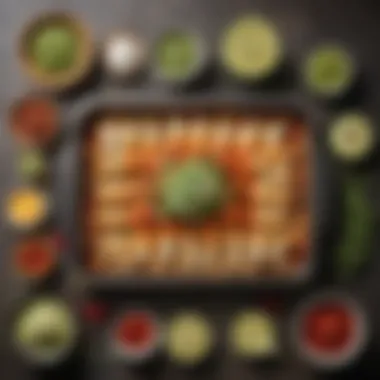
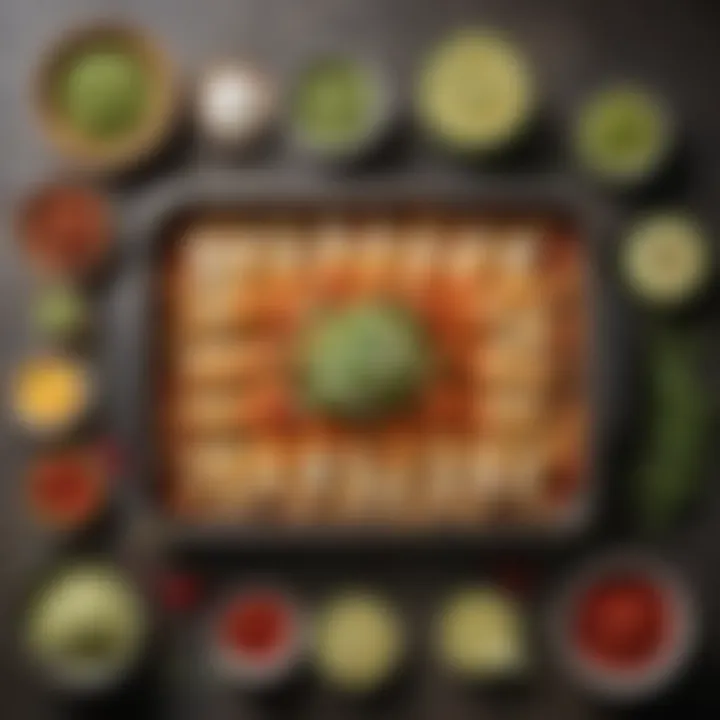
Serving suggestions are crucial for enhancing the overall dining experience when enjoying chicken enchiladas with green sauce. The right accompaniments can elevate the flavors, add texture, and make the meal more satisfying. Choosing complementary side dishes and beverages becomes an integral part of the meal preparation. Alos, one can not overlook that a well-served dish not only pleases the palate but also appeals visually, creating a memorable dining occasion.
Ideal Side Dishes
Choosing the right side dishes for chicken enchiladas with green sauce can enhance the flavors and provide balance to the meal. Common options include:
- Rice: A classic choice is fluffy Mexican rice, which absorbs the flavors of green sauce. Either cilantro-lime rice or Spanish rice can make the dish excitng.
- Beans: Refried beans or black beans are nutritious options that add creaminess and depth.
- Salad: Light salads, such as a fresh green salad with zesty vinaigrette, can offer a refreshing contrast to the rich enchiladas.
- Guacamole: This adds a creamy texture. Plus, the rich flavors of avocado nicely accompany the crispy textures of the chicken.
- Corn: Grilled or roasted corn adds sweetness and visual appeal.
Including one or more of these options can enhance the taste. Also, varying textures helps keep the meal intersting.
Beverage Pairings
The right beverages further complement the chicken enchiladas with green sauce and uplift the overall experience. Consider the following pairings:
- Margaritas: A tangy margarita can balance the flavors of the dish beautifully. Their refreshing quality cuts through richness of cheese and meat.
- Craft Beers: A light lager or a floral IPA can enhance the flavors, matching the spicy notes of green sauce.
- Iced Tea: Unsweetened or lightly sweetened apricot tea can cleanse the palate between bites.
- Water: Sometimes, simplicity triumphs. Serving chilled water with lime slices ensures that guests stay refreshed without overshadowing the tastes of the enchiladas.
- Soda: A citrus soda could match well for those prefering something sweeter and fizzy.
Pair nice drink options that will sure make the experience more joyful and pleasing. It’s key to keep in mind that contrasts in flavor and temperature can elevate enjoyment significantly.
Nutritional Benefits
Balancing taste with health is key for everyday meals. The red chili sauce enchilada variations can be calorie-laden, while this version brings the advantages of thoughtful ingredients and their assorted benefits.
Caloric Considerations
When evaluating the caloric implications of a chicken enchilada with green sauce, several factors are at play. On average, one serving typically contains between 300 to 450 calories depending on the tortilla size, chicken amount, and sauce used. Consider the following points regarding calories:
- Tortilla Type: Flour tortillas often contain more calories than corn tortillas. For health conscious individuals, corn tortillas are suggested due to lower calories.
- Filling Composition: The chicken and cheese will impact the total caloric amount. Using lean chicken can significantly cut calories while retaining protein.
- Portion Size: Smaller servings may reduce caloric intake without sacrificing satisfaction.
Opting for a tomato-green chili mix can further reduce calories while retaining sumptuous flavor.
Health Benefits of Ingredients
The ingredients used in your chicken enchiladas contribute to a more healthful meal. Each component add its own health benefits:
- Chicken: Excellent source of protein which is important for muscle repair and growth while being low in fat when skinless.
- Green sauce ingredients: Often escort tomatillos, onions, and cilantro—each rich in vitamins and antioxidants. Tomatillos have vitamin C and potassium.
- Cheese: Provides calcium vital for bone health. Using light cheese can lower fat and calories.
- Produce Addition: Adding bell peppers and spinach among the filling brings further vitamins A and K, promoting a stronger immune system.
- Fiber: Corn tortillas provide necessary dietary fiber aiding in digestion.
To conclude, embracing the flavors in chicken enchilada with green sauce does not mean giving up nutrition. The choice of ingredients can create a meal low in calories yet rich in essential nutrients—allowing for a balance of enjoyment and well-being.
Variations of the Recipe
Vegetarian Options
For those shifting towards plant-based meals, transforming chicken enchiladas into a vegetarian option can be quite simple and gratifying. One famous technique chai's you to replace chicken with hearty vegetables. Common choices include bell peppers, zucchini, mushrooms, or even beans. Each can be sautéed directly before assembling to add depth of flavor. Faux-meats, like cauliflower or tempeh, can serve to fulfill any craving for protein without straying from a meatless agenda.
Another aspect to focus on is the use of cheese. Many recipes rely on cheese for flavor and depth. Choosing different types of cheese, such as pepper jack or goat cheese, will give the enchiladas a surprising twist. Ensuring a rich sauce not only contributes to taste but also adds moisture to the otherwise dry vegetables.
Incorporating fresh herbs such as cilantro or basil can brighten the dish as well. Popular toppings, including salsa or guacamole, ensure the overall meal appeals to a wide range of guests.
Non-Traditional Ingredients
Embracing innovativeness with non-traditional ingredients can lead to exciting enchiladas that weave ethnic inspirations together. Swapping out the typical corn tortillas for alternatives like spinach or flour tortillas gives the dish a delicate yet bold edge. Furthermore, using unconventional sauces such as avocado crema or yogurt-based salsa verde instead of the classic green sauce adds freshness and a unique flavor profile.
The choice of fillings also allows for creativity; consider integrating unique items like jackfruit, which can mimic shredded chicken, or introducing Asian flavors such as hoisin sauce and fresh well-seasoned vegetables.
Add some spice into the mix. Tacking on different chilies, such as poblano or jalapeño, introduces warmth and depth, muting any overwhelming cheesiness from the dish. Experimentation with globally inspired toppings like mango salsa or a coconut twist can wholly stereotyping exports while enhancing indulgence through unusual creamy textures.
In summary, experimenting rather than settling with only traditional Expectations can turn each enchilada craving into an adventure in flavor. Whether pursuing vegetarian solutions or incorporating non-conventional foods, these variations support a creative table for diverse dining needs.
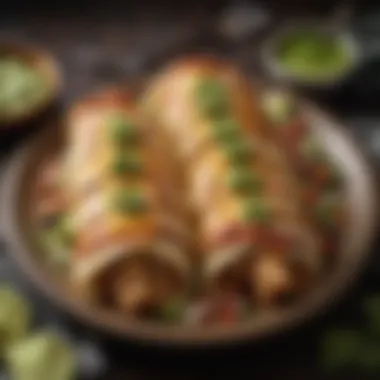
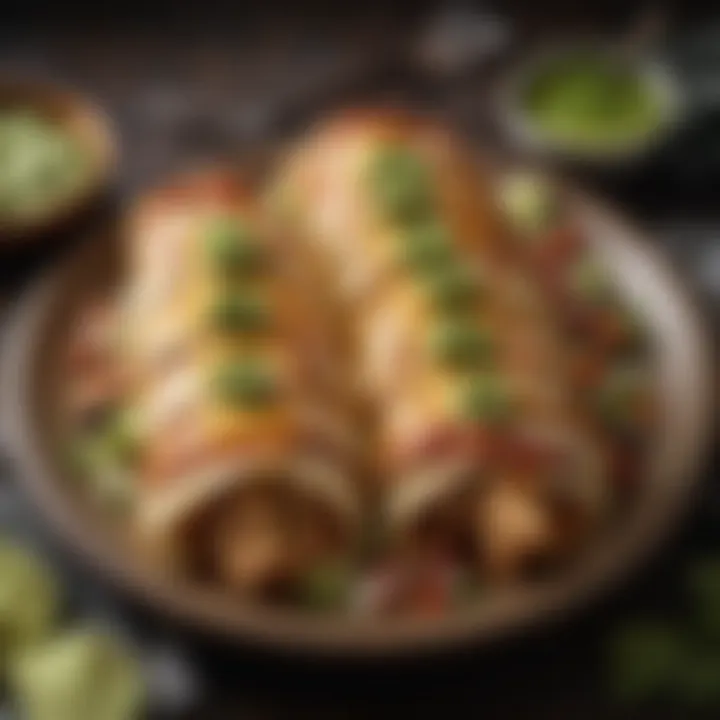
Meal Prep and Storage
Meal prep and storage are essential components when making chicken enchiladas with green sauce. Proper meal prepping saves time during busy weekdays and makes weeknight dinners achievable with less stress. A well-structured meal plan makes it easier to enjoy home-cooked meals, while effective storage extends the freshness and flavor of the enchiladas.
One prominent benefit of meal prepping is reduced cooking time. By preparing large batches and storing them appropriately, individuals can spend less time in the kitchen and still enjoy home-cooked flavors every day. You cut down cooking tasks like chopping, mixing, and cleaning when these are addressed in advance.
Considerations regarding meal prep also include ingredient integrity and flavor conservation. Using fresh ingredients where possible is crucial to enhance the dish's taste. During storage, techniques that retain moisture and prevent spoilage become relevant; for instance, proper sealing slows down the process of freezer burn.
In essence, whether one’s goal is to streamline dinner preparations or maintain the quality of leftovers, understanding meal prep and storage techniques bolsters an individual’s culinary experience. Below are details regarding freezing options and reheating instructions:
Freezing Options
Freezing chicken enchiladas is a straightforward way to preserve these delights for weeks. Begin with assembling the enchiladas. Once they are rolled, you can freeze them before or after baking.
- If choosing to freeze before cooking, lay the enchiladas in a single layer on a baking sheet until firm, then transfer them to airtight containers or heavy-duty freezer bags. This prevents them from sticking together.
- Ensure to label the bags or containers with the date and contents for future reference.
- Freezing after cooking is also viable. Allow the enchiladas to cool completely before storing them. Then, engage the same process of vacuum sealing or utilizing freezer bags. Doing this prevents moisture from escaping, maintaining quality and flavor when a craving hits.
- Chicken enchiladas generally maintain good quality in the freezer for approximately three months.
Reheating Instructions
Reheating your chicken enchiladas properly is crucial not just for taste, but also for food safety. Convenient methods consist of microwave, oven, and stovetop reheating. Each technique allows for adjustment based on available time and desired crispness.
- Microwave: Cover the enchiladas with a damp paper towel in a microwave-safe dish. Heat on medium power in intervals of one to two minutes until heated through, making sure the center is warm to avoid cold spots.
- Oven: Preheat the oven to 350°F. Place enchiladas in an oven-safe dish and cover them with foil to retain moisture while reheating for about 20 to 25 minutes. Opt to remove the foil during the last five minutes for a toasted finish.
- Stovetop: For those preferring a quick heat-up method without an oven, wrapping enchiladas in foil and placing in a skillet over medium-low heat allows them to warm evenly. Flip occasionally while keeping covered, for a perfect reheating experience.
Maintaining an understanding of these meal prep and storage options ensures that your chicken enchiladas remain a staple within your culinary routine while crafting delightful dining experiences.
Common Mistakes to Avoid
Avoiding common mistakes in making chicken enchiladas ensures a more enjoyable meal. Missteps can lead to an unsatisfactory dining experience, and are often the result of oversight or inexperience. Understanding these pitfalls not only saves time but also enhances flavor, texture, and presentation.
Overfilling the Enchiladas
One major mistake that many home cooks make is overfilling the enchiladas. While the instinct might be to add a hearty amount of filling for that rich flavor, too much can make each enchilada unwieldy. Overfilling can result in several issues:
- Difficulty in rolling: Tight spacing limits the ability to properly roll the tortilla, which may lead to torn tortillas.
- Potential spillage: Excess filling may leak out during cooking, exposing the enchiladas to uneven heating and a messy appearance.
- Longer baking time: More filling increases the cooking time, which can result in dry tortillas.
- Poor presentation: When cut, overfilled enchiladas tend to fall apart, making them less visually appealing.
To avoid these problems, a good rule of thumb is to use about one-third of a cup of filling per tortilla. This allows for even distribution and keeps the enchiladas intact during cooking. Experiment with amounts until you find what best works for your tastes, while staying within that limit.
Using Stale Tortillas
Utilizing stale tortillas is a second notable mistake. Tortillas have a short shelf life, and using stale ones diminishes the overall quality of your final dish offerings. Stale tortillas are typically dry and prone to cracking, which leads to:
- Unaesthetic breaks: When the tortillas shatter during assembly, the fillings spill out, leading to an unsightly plate.
- Inadequate flavor: Stale tortillas do not contribute to the mouthfeel and taste barrier that fresh tortillas provide, leading to less enjoyable flavors.
- Texture issues: A crispy texture rather than soft means the enchiladas won't be as ideal to eat, coming off more rubbery than chewy.
To mitigate this mistake, always check your tortillas before use. If they are hard, try warming them slightly or consider purchasing fresh ones from the store. Tortillas should feel pliable, making them easier to roll without breaking. Storing tortillas properly also ranks amoung priority measures—wrap them and keep them in a cool spot. Quality appliances can significantly influence the outcomes too.
To summarize, focusing on the key elements such as preserving the structural integrity of enchiladas and fresh ingredients not only results in a better dish but ensures a delightful dining experience for your family and friends.
End
In wrapping up the discussion on chicken enchiladas with green sauce, it is imperative to highlight several key aspects. This dish not only embodies a harmonious blend of flavors and textures but also serves up a comforting meal experience that caters to a variety of tastes. The steps provided throughout the article emphasize ease of preparation, which is essential for today's busy individuals.
Understanding the nuances of this recipe paves the way for rewarding culinary practice. Notably, the selection of a vibrant green sauce contributes to the depth of flavor while offering nutritional benefits from the ingredients used. Therefore, whether you're crafting a meal for family or sharing with friends, knowing how to prepare your chicken enchiladas allows for both personal creativity and guest enjoyment.
Another critical element worth acknowledging is the capacity for variations. This article demonstrates the flexibility of the recipe. You can experiment with vegetarian options or non-traditional ingredients, adjusting the dish to fit personal or dietary preferences. Such adaptability can make the enchilada a staple in any kitchen.
Maintaining a focus on common mistakes provides further support, ensuring that even amateur cooks can avoid pitfalls and create delightful outcomes. Pay particular attention to filling sizes and tortilla freshness to elevate the final presentation and taste.
"A well-prepared dish is a reflection of both skill and love for the craft."
Concisely, this discussion champions the chicken enchilada as more than just a meal. It's an opportunity for exploration in flavors and techniques, fostering home cooking and the joy of shared meals in every season. Now, as you stand ready to embark on your culinary adventure, remember that each bite is laden with purpose, tradition, and flavor—elements that define genuine cooking and dining experiences today.
Final Thoughts on Chicken Enchiladas
As we conclude, it is essential to front the idea that chicken enchiladas with green sauce can indeed cater to diverse palates. Through understanding and applying the components of preparation, cooking methods, and serving styles, anyone can confidently create this classic dish.
Beyond taste, this recipe embodies warmth and thoughtful cooking. Recipies like this one strengthen family connections and friendships over heartfelt meals. Remember to relish every step of making your enchiladas. The enthusiasm for home-cooked dishes grows in a world that drives fast-food culture. Chicken enchiladas with green sauce hold a significant position in advocating for homemade plates over pre-packaged succulence. Thus, let us return to the kitchen often to embrace rich traditions fused with modern convenience.







